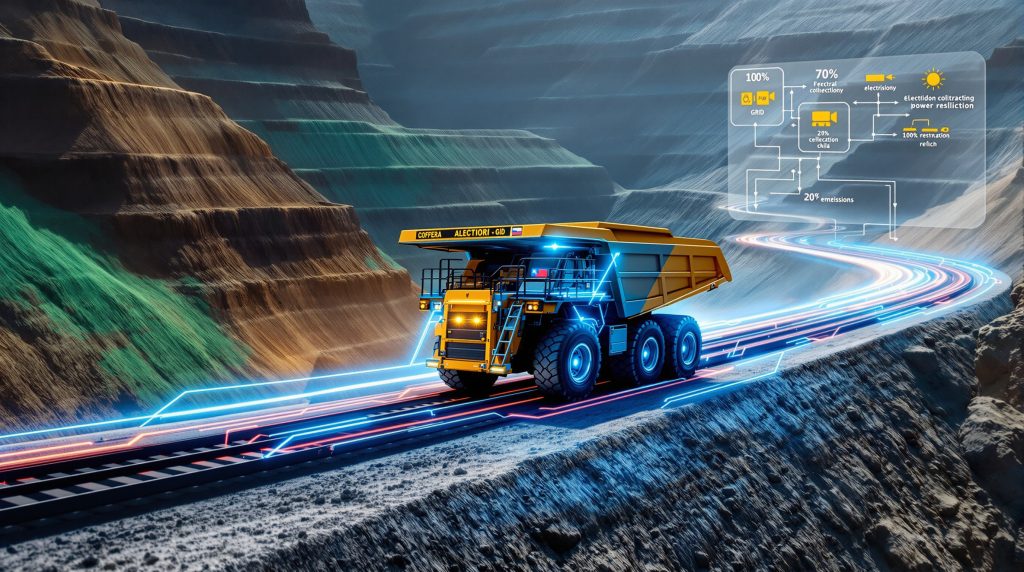How Is Codelco Revolutionizing Mining with Dynamic Energy Transfer Technology?
Codelco, Chile's state-owned copper giant, is setting new standards for mining electrification with an innovative approach that could transform how the industry addresses its carbon footprint. The Dynamic Energy Transfer (DET) system represents a significant leap forward in mining industry innovation technology, offering a practical pathway toward decarbonization while maintaining operational efficiency.
The Evolution of Mining Electrification
The mining industry faces mounting pressure to reduce emissions while maintaining productivity levels that support global demand for minerals. Traditional diesel-powered haul trucks, which form the backbone of mining operations worldwide, contribute significantly to mine-site emissions and operating costs.
Historically, mining companies have faced a challenging dilemma: continue using proven diesel technology despite environmental impacts, or invest in complete fleet replacement with emerging zero-emission alternatives that may present operational uncertainties.
This gap between current operations and future sustainability goals has created demand for intermediate solutions that can deliver immediate environmental benefits while supporting longer-term transition strategies.
What Makes Dynamic Energy Transfer Systems Groundbreaking?
The Codelco Dynamic Energy Transfer system represents an innovative approach to mining electrification by allowing heavy mining vehicles to receive power while in motion. Unlike traditional electrification methods that require complete infrastructure overhauls or fleet replacements, DET works with existing diesel-electric trucks.
The system consists of three integrated components working in harmony:
- Power conversion infrastructure that transforms electricity from the mine's power grid to appropriate voltage levels
- Electrified aluminum rail system installed along strategic sections of haul roads and ramps
- Vehicle-mounted outriggers that maintain continuous contact with the rails during operation
This configuration enables trucks to seamlessly transition between powered and unpowered sections without interrupting operations, maintaining productivity while reducing emissions.
According to preliminary calculations shared by Felipe Lagno, Codelco's corporate manager of innovation and technology, the technology could reduce truck emissions by an impressive 60-70% when implemented.
Inside Codelco's Strategic Partnership with Caterpillar
The development and implementation of the DET system exemplifies effective industry collaboration through a strategic three-way partnership:
- Codelco: Provides the operational environment and defines real-world requirements
- Caterpillar: Delivers the core technology and system integration expertise
- Finning S.A.: Supports installation, maintenance, and operational aspects as Caterpillar's dealer
"This pilot program is the result of extensive collaboration between Codelco, Finning S.A. and Caterpillar, and will allow Caterpillar to continue refining and improving the design and functionality of our Cat DET system, incorporating customer feedback," explained Marc Cameron, senior vice president of Caterpillar.
The partnership leverages each organization's strengths to accelerate innovation while ensuring the technology addresses practical operational challenges. Juan Pablo Amar, president of Finning, characterized the trial as "a significant opportunity to advance the integration of cutting-edge technologies in mining," highlighting how their long-standing relationship with Codelco facilitates this pioneering work.
Technical Breakdown: How DET Systems Function in Mining Operations
The DET system creates electrified corridors along strategic sections of mine haul roads where energy consumption typically peaks, such as steep ramps. As trucks travel along these routes, the specialized outriggers mounted on the vehicles maintain continuous contact with the electrified rails.
Power Transfer Mechanics
The system works by establishing an electrical connection between the stationary infrastructure and moving vehicles. This connection allows power to flow directly to the truck's electric drive system while in motion, even on steep inclines where energy consumption typically peaks.
When a truck enters an electrified section, the outrigger automatically establishes contact with the rail system. Power flows through this connection directly to the truck's electric drive motors, either supplementing or replacing the diesel engine's contribution depending on operational requirements.
Technical Integration Points
The DET system integrates with existing mine infrastructure through:
- Power transfer modules that condition electricity from the mine's grid to appropriate voltage levels
- Conductive rail infrastructure strategically installed along high-energy-consumption routes
- Truck-mounted connection systems that interface with the vehicle's existing powertrain
This architecture allows for flexible implementation, as mines can prioritize electrification of sections where the environmental and operational benefits will be greatest, such as steep ramps where diesel engines operate under maximum load.
Why Radomiro Tomic Division Was Selected for the Pilot
Codelco's decision to implement the pilot at its Radomiro Tomic Division reflects strategic consideration of multiple factors that make the site ideal for testing this transformative technology.
The Radomiro Tomic operation, located in Chile's copper-rich Antofagasta Region, provides diverse terrain including significant elevation changes that create ideal conditions for evaluating the DET system's performance during high-energy-consumption operations like uphill hauling.
The pilot program follows a structured timeline:
- Planning and preparation (Current phase)
- Installation of rail infrastructure (Early 2026)
- System commissioning (Q2 2026)
- Operational testing (12-month duration)
- Performance evaluation (Mid-2027)
- Decision on broader implementation (Late 2027)
The pilot will utilize three Cat 798 AC diesel-electric haul trucks equipped with specialized connection systems, with electrified rail sections installed on key ramps to maximize impact while limiting initial infrastructure investment.
What Environmental Impact Reductions Can Be Expected?
The environmental benefits of the DET system represent one of its most compelling advantages. According to a report from Mining.com, preliminary calculations suggest truck emissions could be reduced by between 60% and 70% through implementation of the technology.
These projections make the DET system an attractive option for mining companies seeking to balance operational requirements with environmental responsibilities. The system achieves these reductions through multiple mechanisms:
- Direct displacement of diesel consumption during operation on electrified sections
- Reduced engine operating hours under high-load conditions
- More efficient energy utilization through direct electrical power delivery
- Potential for renewable energy mining solutions into the power supply
Beyond emissions reduction, the system offers the additional environmental benefit of potentially extending equipment service life by decreasing cumulative engine operating hours under high-stress conditions, reducing the resource intensity of fleet replacement cycles.
Economic Analysis: The Business Case for Dynamic Energy Transfer
While environmental benefits drive much of the interest in the DET system, the technology also offers compelling economic advantages that strengthen its business case:
- Reduced fuel costs through partial electrification of haul truck operations
- Extended equipment life by decreasing engine operating hours under high-load conditions
- Improved productivity potential by maintaining consistent power during uphill hauls
- Staged implementation allowing gradual capital investment aligned with operational budgets
- Compatibility with existing fleets avoiding the capital expense of complete fleet replacement
These factors create a multi-faceted value proposition that complements the environmental benefits, making the technology appealing from both sustainability and economic perspectives.
The staged implementation approach allows mining companies to prioritize electrification in areas with maximum potential impact, such as steep ramps where fuel consumption is highest, optimizing the return on infrastructure investment.
How DET Fits Into Mining's Broader Electrification Roadmap
The DET system represents an important step in the evolution of mining equipment electrification, positioning it as a bridge technology in the progression toward fully zero-emission mining operations.
This evolution follows a logical pathway:
- Traditional diesel – conventional combustion engines
- Diesel-electric hybrid – improved efficiency through partial electrification
- Dynamic power transfer – reduced emissions through infrastructure-based electrification
- Full battery-electric – zero-emission vehicles with onboard energy storage
The DET system occupies a strategic middle position in this progression, offering immediate emissions reductions with existing equipment while building organizational capabilities and infrastructure that support future zero-emission technologies.
This technology allows mining companies to begin decarbonization efforts immediately rather than waiting for battery technology to mature or complete fleet replacement cycles, creating a practical transition strategy that balances environmental goals with operational realities.
Overcoming Implementation Challenges
Despite its promise, the Codelco Dynamic Energy Transfer system faces several practical challenges that must be addressed for successful implementation:
Infrastructure Integration
Integrating electrified rail infrastructure into existing mine layouts requires careful planning and engineering to ensure compatibility with current operations. Key considerations include:
- Identifying optimal locations for rail installation based on energy consumption patterns
- Designing rail systems that withstand mining conditions including heavy traffic and environmental exposure
- Planning installation schedules that minimize operational disruption
- Ensuring compatibility with existing electrical infrastructure
Operational Considerations
From an operational perspective, the system introduces new elements that mining teams must incorporate into daily activities:
- Training operators on system interaction and transition between powered and unpowered sections
- Developing maintenance protocols for both the rail infrastructure and vehicle-mounted components
- Establishing safety procedures for working around electrified systems
- Creating monitoring systems to track performance and identify optimization opportunities
Mitigation Strategies
The pilot program incorporates several approaches to address potential obstacles:
- Phased implementation focusing initially on high-impact areas
- Comprehensive training programs for operational and maintenance personnel
- Robust safety protocols for working with electrified systems
- Weather-resistant designs adapted to mining conditions
- Redundant systems to ensure operational continuity
These strategies help manage risks while maximizing the potential benefits of the technology.
How Can Mining Companies Prepare for This Technology?
Forward-thinking mining operations interested in similar technologies should consider a structured assessment approach to determine suitability and implementation requirements:
Assessment Framework
- Route analysis – identifying high-fuel-consumption areas that would benefit most from electrification
- Electrical infrastructure assessment – evaluating power availability and distribution capabilities
- Fleet compatibility evaluation – determining which vehicles could be adapted for the technology
- Economic modeling – calculating potential ROI based on fuel savings and emissions reduction
- Implementation roadmap – developing a phased approach to deployment
This methodical evaluation helps determine whether the technology aligns with specific operational needs and constraints.
Strategic Planning Considerations
Beyond technical assessment, mining companies should incorporate broader strategic elements into their planning:
- Workforce development – building technical capabilities for maintaining electrified systems
- Energy sourcing – exploring renewable energy integration to maximize environmental benefits
- Regulatory engagement – understanding how emissions reduction technologies align with current and anticipated regulations
- Stakeholder communication – developing messaging around sustainability initiatives and technological innovation
These preparations position operations to adopt emerging technologies effectively as they mature, ensuring alignment between technical capabilities, operational needs, and strategic objectives.
FAQ: Key Questions About Dynamic Energy Transfer Systems
How does the DET system impact truck performance?
The system maintains or potentially improves truck performance by providing consistent power delivery, particularly on inclines where diesel engines typically struggle. This can result in more consistent cycle times and potentially higher productivity.
What safety features are incorporated into the system?
The DET system incorporates multiple safety features, including automatic power isolation in case of system faults, protective barriers around electrified components, comprehensive grounding systems, operator alerts when entering and exiting powered zones, and emergency shutdown capabilities.
Can existing trucks be retrofitted for this technology?
Yes, a key advantage of the DET system is its compatibility with existing diesel-electric haul trucks. Retrofitting involves installing the connection mechanism and integrating with the truck's electrical system, making it more accessible than full fleet replacement.
What is the expected return on investment timeline?
While specific ROI varies based on mine conditions, fuel prices, and utilization rates, preliminary analyses suggest potential payback periods of 3-5 years through reduced fuel consumption, lower maintenance costs, and extended equipment life.
How does weather affect system reliability?
The system is designed to operate in various weather conditions, with weatherproofing for rain and dust protection. Extreme conditions may require additional protective measures, which are being evaluated as part of the pilot program.
Expert Perspectives on Mining's Electrified Future
The mining industry's transition toward electrification represents a fundamental shift in how operations approach energy consumption, environmental impact, and technology adoption. The integration of electric vehicles in mining operations exemplifies how innovative approaches can bridge current operational requirements with future sustainability goals.
As Felipe Lagno articulated, technologies like the DET system represent steady progress "toward the mine of the future," creating opportunities to reduce environmental impact while maintaining or enhancing productivity. This balanced approach acknowledges the practical realities of mining operations while embracing innovation that drives positive change.
The collaborative model demonstrated by Codelco, Caterpillar, and Finning provides a template for how mining companies can participate in the global innovation expo ecosystem to accelerate innovation and implementation, sharing expertise and resources to overcome challenges and realize new possibilities.
As the industry continues its sustainable mining transformation, technologies like the Codelco Dynamic Energy Transfer system will play an increasingly important role in helping mining companies meet environmental commitments while delivering the minerals and metals essential to global economic development and the clean energy transition.
Ready to Capitalise on the Next Mining Innovation?
Discover emerging opportunities in resource sector transformations with Discovery Alert's proprietary Discovery IQ model, delivering instant notifications on significant ASX mineral discoveries that could mirror the innovative impact of Codelco's electrification breakthroughs. Explore historic returns from game-changing discoveries by visiting our dedicated discoveries page and position yourself ahead of the market.




